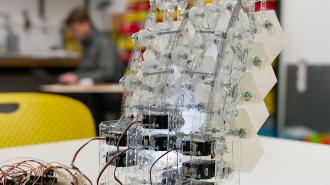Robots are already beginning to transform our homes and workspaces, but one day they could be integrated into every aspect of a room’s design. In the future, these “robot rooms” could create dynamic indoor spaces that transform according to their users’ needs.
The challenge: Demands on the spaces where we live, work, and play are now changing faster than ever. This shift was accelerated by the pandemic – which for many of us saw our homes suddenly transformed into offices, social spaces, schools, and playgrounds.
Traditional approaches to designing indoor spaces may be entirely unsuited to many human lifestyles in the near future.
This trend is only set to continue, especially as remote working continues to gain traction. However, the demands on our indoor spaces are also coupled with numerous other aspects of our changing world. As trends in urbanization see global populations migrating into cities, many people’s living spaces are shrinking, and becoming more disconnected from nature.
Added to this, rapidly aging populations across the developed world are stretching the resources of assisted living services.
For some researchers, this multitude of intersecting challenges ultimately suggests that traditional approaches to designing indoor spaces will be entirely unsuited to many human lifestyles in the near future. However, through the combined advances of AI and robotics, conceptions about the rooms where we spend much of our lives have already begun to shift.
Robots are the room: Today, many of our homes are fitted with smart devices that respond to our voice commands, and sense heat or movement. They turn on the lights, vacuum the floors, and listen to music, without us even touching the devices involved.
What if robots weren’t just in the room, but were themselves the room?
For Keith Evan Green at Cornell University’s Architectural Robotics Lab, the scope of these technologies could stretch far further still.
Through his research, Green asks the question: what if robots weren’t just in the room, but were themselves the room? His idea is that intelligent systems could be entirely engrained with all aspects of the room’s design: from the layout of furniture, to the scenes displayed on the walls and ceilings.
Green and his colleagues have now spent over 20 years exploring the exciting possibilities of spaces they have dubbed “robot rooms.” Their work has inspired several different research projects, each exploring a different aspect of newly-emerging technologies in AI and robotics.
The projects: One branch of Green’s research is the Animated Work Environment project, which explores how furniture and wall panels could move around the room in response to voice commands, body gestures, or even intuitive AI algorithms.
This could allow users to optimize their living spaces for specific tasks: for example a single room could be a productive office environment during the day, then be transformed into a space for hosting friends in the evening.
The home+ project investigates how agile robotic furniture such as lamps or side tables could be programmed to climb walls, and place or retrieve items from floors and shelves. If achieved, this could enable elderly or disabled users to store, access, and organize their belongings more easily – helping them to live more independent lives.
In the LIT ROOM project, Green’s team explores how to create immersive environments by programming walls and ceilings to change shape, and display particular sounds and colors. They imagine these patterns changing to accompany a user’s voice as they read a children’s story aloud, or allowing them to explore calming virtual worlds – offering far more immersive experience than simply looking at a screen.
Indoor spaces of the future: While these projects have seen promising progress so far, Green’s team believe that they have only just scratched the surface of the robot room’s full potential. By smartly monitoring a user’s biometric signatures, the systems could check for signs of emergency health issues in elderly or disabled users, as well as hospital patients.
More advanced robotics could one day be used to cultivate indoor gardens, with plants embedded into walls and furniture. This could help users to feel closer to nature in dense urban environments, and even grow their own food indoors. Beyond transforming indoor spaces, Green also envisages that robot rooms could help to optimize cramped spaces inside self-driving cars and public transport – improving comfort for their users.
Smarter approaches to designing indoor spaces could help us to adapt to an uncertain and rapidly transforming society.
In the future, Green hopes these same principles could be applied to assist astronauts on long space station missions or interplanetary voyages, or inside habitats on the moon or Mars. By helping these explorers to make the most of extremely limited spaces, and better maintaining their mental wellbeing, robot rooms could one day become a crucial aspect of these daring missions.
Ultimately, by harnessing the fast-developing power of AI and robotics for good, Green hopes that smarter approaches to designing indoor spaces will one day enrich our everyday lives, and help us to adapt to an uncertain and rapidly transforming society.
We’d love to hear from you! If you have a comment about this article or if you have a tip for a future Freethink story, please email us at tips@freethink.com.
